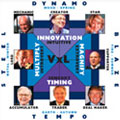101 Great Ideas to Boost Your Business
Posted on October 27, 2010 by CJ Article Team
 The book under review, 101 Great Ideas to Boost Your Business is written by Kirti Desai, a marketing expert. Desai is currently engaged as a business consultant guiding entrepreneurs on how to sail their businesses through troubled waters.
The book under review, 101 Great Ideas to Boost Your Business is written by Kirti Desai, a marketing expert. Desai is currently engaged as a business consultant guiding entrepreneurs on how to sail their businesses through troubled waters.
This author says most books on personal or business success start with the theory that you need to understand, digest and then put into practice. He submits that this text is different as it bypasses the theory part and straightaway hits the practical road by showing you 101 ways through which you can enhance your business.
Structurally, this text is segmented into eight parts of 101 of ideas. Part one is eclectically christened Product and covers the first 12 ideas. The first idea is entitled Observe your product or service from the customer’s point of view. In the words of this expert here, “Trying placing yourself in the customer’s shoes and see how you feel. It is human nature that everyone likes his own child and the same thing applies to our product too. But it is not what we think of our product or service that matters; our success depends on what our customers think of our product or service.”
Desai says it is easy to know what the customers want because it is the same thing that you want for yourself, when you buy a product or service. This expert asks that to be honest, would you buy your product or service as it is offered to the general consumers? He submits that if your answer is in the affirmative, then you are in business, but if there is even a slight hitch, you need to find out what prohibits you to go in for the product.
“Is it the price, or the utility of the product, or do you have any doubt about its performance? Whatever it may be, give a serious thought and come to a conclusion. But do not stop here; take corrective measures right away until you are fully satisfied with the product. Sometimes, companies purposely send customers to their branches, their agents and dealers just to monitor how their customers are treated,” illuminates Desai.
Idea number two is based on the subject matter of expanding your product range. Here, this author advises you to take a look at consumer durable product companies, where each one has a wide range of products to offer. According to him, “A household appliance manufacturer has refrigerators, air conditioners, washing machines, and now even, microwave ovens. Not only that, each category also has a wide range to offer the maximum choice to consumers.”
Ideas three to 12 are based on the need to keep adding value to your product or service; going for ‘mass-volume’ product; targeting an upper-end market; revamping your product portfolio; promoting new and more usage of your product or service; having a catchy brand name, attractive logo and smooth slogan; building a strong brand image for your product or service; extending your brand name to other products; striking a balance between cost and value of your product; and diversifying but remaining within your core competence area.
Part two is generically tagged Customer and contains 11 ideas, that is, 13 to 23. Here, Desai examines concepts such as having knowledge of your customers; ensuring customer satisfaction; respecting your customers and valuing their money; expanding your consumer base; retaining customer attention always; learning to retain clients; creating ‘trust’ among consumers; having few prestigious clients; forgetting brand and ensuring customer loyalty; making your customers partners and keeping an eye on your future prospects.
Part three has a broad thematic focus of Competition and covers six ideas, that is, 24 to 29. Idea number 24 is labelled Face it, competition is here to stay. In the words of this marketing expert here, “Monopoly is a forgotten word in today’s business dictionary. Take any field and there are many players, many products, each one having its own identity, and each one trying to grab the other’s market. On top of that, there will be more players, more products coming in, making the market worse than a battlefield. In a battlefield you commonly fight one enemy at a time, here you will be facing many of them simultaneously.”
Idea 25 is entitled Learn to live with competition and learn to beat it. According to Desai, we are living in a world of competition, be it in our business, our jobs, etc. He says you cannot escape from competition, what you can rather do is to create your product and marketing strategy such that yours will be different from others. In Desai’s words, “Avoid direct confrontation with competitors. Find another way to reach your customers. If your competitors are heavy on advertising then go for promotional schemes like free gifts, discounts, lucky coupons, etc. Study your competitors minutely, including their products, business strategy, distribution network, price structure, promotional offers, future planning, etc. Now compare it, segment-to-segment with yours. See where you stand.”
Idea 26 is tagged Join hands with competitors for common interest. This marketing expert says tough times call for tough decisions, even if it means sleeping with the enemy. According to him, “Competitors are no more enemies, they are just rivals in business… You have taken all the steps to control cost, but you are still missing out on one important area and that is, joining hands with your competitors. Surprised? Well, this is the demand emerging from modern business concepts and trends. You can save a lot, here is how. Fiat and General Motors (GM), the world’s largest automobile makers, are exploring the possibility of setting up a power train-cum-engine plant at the Italian major’s facility in Ranjangaon, Maharashtra…The Japanese company Suzuki, a partner in Maruti is also a partner in the GM-Fiat global alliance, could use the diesel engines produced in India.”
Ideas 27 to 29 are based on getting prepared for fresh competition always; beating the giants through innovative ideas and getting prepared for performance guarantee.
Part four is summarily woven together as Price, promotion and distribution and covers ideas 30 to38. Desai says proper and reasonable price attracts customers to buy your product; distribution helps you reach your consumers and promotion helps you to let your potential consumers know of your product and also lure them to buy the product.
Part five is generally labelled Internal operations and accommodates ideas 39 to 54.
In part six based on an umbrella concept of expanding business, Desai examines 20 ideas covering numbers 55 to 74.
In part seven which is based on the generic subject matter of extra tips and contains 23 ideas spanning numbers 75 to 97, this author says you as an individual can do a lot by following these 23 solid ideas and just see the result you will get.
Part eight, the last part has the prcis concept of Action and covers the remaining four ideas, that is, numbers 98 to 101.
As regards presentation mode, Desai says, “The book is not prepared in any particular format. In order to facilitate better understanding of the subject and the concept, I have created a sequence, which shall help you grasp the themes better.”
Meanwhile, by segmenting this text into eight different parts covering 101 ideas, with each part focusing on a specific business topic accommodating related ideas, Desai is able to inject simplicity and easy-study ability into the text. The language of the text is technical yet contextually comprehensible.
However, one of the errors noticed in the text is the use of the uncountable collective noun “Machinery” in the plural form “Machineries” on page five. Another one is omission of quotation mark from the word “Monopoly” in the first line of page 85 thus: Monopoly is a forgotten word in today’s business dictionary. It needs to be quoted since it is referred to here as a word in the dictionary.
Generally, this text is fantastic. It is a must-read and the tips must-apply for business organisations and entrepreneurs, especially those that are still ignorant of what Competition means in today’s business environment and instead hold on to Gore Vidal’s archaic and barbaric win-lose competition concept, which says, “It is NOT ENOUGH for you to succeed. Competitors MUST ALSO fail by all means.”
GOKE ILESANMI, Editor-in-Chief/CEO of http://www.gokeilesanmi.com and Managing Consultant/CEO of Gokmar Communication Consulting, is a Certified Public Speaker/Emcee, (Business) Communication Specialist, Motivational Speaker, Career Management Coach, Renowned Book Reviewer, Corporate Leadership Expert and Editorial Consultant.
Tel: +234(0)8055068773; Tel: +234(0)8056030424 Email: gokeiles2010@gmail.com; info@gokeilesanmi.com
GOKE ILESANMI, Editor-in-Chief/CEO of www.gokeilesanmi.com and Managing Consultant/CEO of Gokmar Communication Consulting, is a Certified Public Speaker/Emcee, (Business) Communication Specialist, Motivational Speaker, Career Management Coach, Renowned Book Reviewer, Corporate Leadership Expert and Editorial Consultant.
Article Source: http://EzineArticles.com/?expert=Goke_Ilesanmi
By Goke Ilesanmi
Facebook Comments:


































